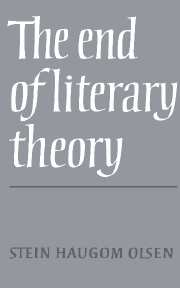Book contents
- Frontmatter
- Contents
- Preface
- Literary aesthetics and literary practice
- Interpretation and intention
- Authorial intention
- Text and meaning
- The ‘meaning’ of a literary work
- Defining a literary work
- What is poetics?
- On unilluminating criticism
- Criticism and appreciation
- Value-judgements in criticism
- Literature, fiction, and reality. A problematic relationship
- Thematic concepts: where philosophy meets literature
- Literary theory and literary aesthetics
- Notes
- Bibliography
- Index
Criticism and appreciation
Published online by Cambridge University Press: 05 November 2011
- Frontmatter
- Contents
- Preface
- Literary aesthetics and literary practice
- Interpretation and intention
- Authorial intention
- Text and meaning
- The ‘meaning’ of a literary work
- Defining a literary work
- What is poetics?
- On unilluminating criticism
- Criticism and appreciation
- Value-judgements in criticism
- Literature, fiction, and reality. A problematic relationship
- Thematic concepts: where philosophy meets literature
- Literary theory and literary aesthetics
- Notes
- Bibliography
- Index
Summary
ONE
Consider the following description (the undergraduates' description) of Aeschylus' Agamemnon:
the watchman appears, sees the signal fires which mean that Troy has fallen, utters a dark hint or two, and disappears forever from the play. The Chorus enters and offers, by way of entertainment, a history of the Trojan war, with a long special appendix on the sacrifice of Iphigenia. Clytemnestra enters and interprets the signal fires quite correctly; and the Chorus refuses to believe her, apparently on no better ground than that she is merely a woman. A herald comes in, tells them the same thing, and they believe him (he, you see, is a man). The play is half over before Agamemnon appears. He becomes immediately involved in an argument with Clytemnestra over the interesting question of whether he will or will not walk on the red carpets which she has spread for him. He proves conclusively that he ought not to, and then does walk on them after all, of course, for he is a married man. … Cassandra finally speaks, and we have one of the greatest failures of communication in history. Presently, from off-stage, Agamemnon gives us a blow-by-blow account of his own murder. And that is pretty much that.
This is a parodic presentation of what is in fact an ‘undergraduate understanding’ of Aeschylus' play. It is obviously inadequate, not merely because it is synoptic but because it fails to provide any concepts which could be used to illuminate the different scenes to which it refers.
- Type
- Chapter
- Information
- The End of Literary Theory , pp. 121 - 137Publisher: Cambridge University PressPrint publication year: 1987



